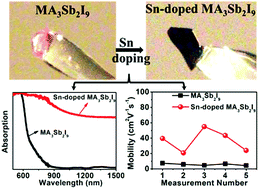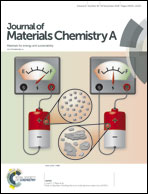Narrow band gap and high mobility of lead-free perovskite single crystal Sn-doped MA3Sb2I9†
Abstract
Sb-based perovskite structures have been studied as the potential materials to replace lead hybrid perovskite. However, their broad band gap makes them unsuitable for single-junction solar cells, which spurred researchers to design new strategies to narrow the band gap and broaden their photovoltaic application. Herein, a general doping strategy was designed to obtain lead-free and large size Sn-doped MA3Sb2I9 single crystals. Their crystal structures and valence states were investigated in detail by X-ray diffraction and the X-ray photoelectron spectroscopy, revealing distinct lattice expansion, thus demonstrating the successful doping of Sn2+. After the doping of Sn2+, a significant 296 nm red-shifted light absorption peak was clearly observed, and the carrier mobility enhanced by about two-fold, as investigated by space charge-limited current (SCLC) and Hall effect measurements. The trend of the band gap determined by the first-principles calculations matches well with that of experiments. The corresponding narrowing mechanism of band gap after the doping is also revealed in detail. These extremely promising photoelectric properties of Sn-doped MA3Sb2I9 shown herein motivate further exploration of their photovoltaic application.



 Please wait while we load your content...
Please wait while we load your content...